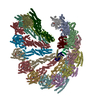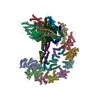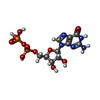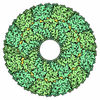[English] 日本語
 Yorodumi
Yorodumi- PDB-9i8h: Outwards conformation' of the human gamma-TuRC from purified cent... -
+ Open data
Open data
- Basic information
Basic information
| Entry | Database: PDB / ID: 9i8h | |||||||||||||||
|---|---|---|---|---|---|---|---|---|---|---|---|---|---|---|---|---|
| Title | Outwards conformation' of the human gamma-TuRC from purified centrosomes obtained by rigid body docking | |||||||||||||||
 Components Components |
| |||||||||||||||
 Keywords Keywords | CELL CYCLE / centrosome / cytoskeleton / microtubule / microtubule nucleation / complex / template / cap / gamma-tubulin / gamma-tubulin ring complex / nedd1 / neural precursor cell-expressed developmentally down-regulated 1 / CDK5RAP2 / cyclin-dependent kinase 5 regulatory subunit associated protein 2 | |||||||||||||||
| Function / homology |  Function and homology information Function and homology informationmicrotubule nucleation by interphase microtubule organizing center / gamma-tubulin complex localization / microtubule nucleator activity / positive regulation of norepinephrine uptake / polar microtubule / interphase microtubule organizing center / gamma-tubulin complex / gamma-tubulin ring complex / cellular response to cytochalasin B / bBAF complex ...microtubule nucleation by interphase microtubule organizing center / gamma-tubulin complex localization / microtubule nucleator activity / positive regulation of norepinephrine uptake / polar microtubule / interphase microtubule organizing center / gamma-tubulin complex / gamma-tubulin ring complex / cellular response to cytochalasin B / bBAF complex / mitotic spindle microtubule / npBAF complex / nBAF complex / brahma complex / meiotic spindle organization / regulation of transepithelial transport / Formation of annular gap junctions / morphogenesis of a polarized epithelium / Formation of the dystrophin-glycoprotein complex (DGC) / structural constituent of postsynaptic actin cytoskeleton / Gap junction degradation / GBAF complex / Folding of actin by CCT/TriC / regulation of G0 to G1 transition / protein localization to adherens junction / Cell-extracellular matrix interactions / microtubule nucleation / dense body / postsynaptic actin cytoskeleton / Tat protein binding / gamma-tubulin binding / Prefoldin mediated transfer of substrate to CCT/TriC / RSC-type complex / regulation of double-strand break repair / regulation of nucleotide-excision repair / non-motile cilium / Adherens junctions interactions / RHOF GTPase cycle / adherens junction assembly / apical protein localization / Sensory processing of sound by outer hair cells of the cochlea / Interaction between L1 and Ankyrins / tight junction / SWI/SNF complex / regulation of mitotic metaphase/anaphase transition / Sensory processing of sound by inner hair cells of the cochlea / positive regulation of T cell differentiation / apical junction complex / positive regulation of double-strand break repair / regulation of norepinephrine uptake / transporter regulator activity / maintenance of blood-brain barrier / nitric-oxide synthase binding / cortical cytoskeleton / NuA4 histone acetyltransferase complex / establishment or maintenance of cell polarity / pericentriolar material / positive regulation of stem cell population maintenance / cell leading edge / Regulation of MITF-M-dependent genes involved in pigmentation / Recycling pathway of L1 / microtubule organizing center / brush border / mitotic sister chromatid segregation / regulation of G1/S transition of mitotic cell cycle / EPH-ephrin mediated repulsion of cells / kinesin binding / negative regulation of cell differentiation / mitotic spindle assembly / RHO GTPases Activate WASPs and WAVEs / regulation of synaptic vesicle endocytosis / positive regulation of myoblast differentiation / single fertilization / RHO GTPases activate IQGAPs / regulation of protein localization to plasma membrane / positive regulation of double-strand break repair via homologous recombination / spindle assembly / cytoplasmic microtubule / cytoplasmic microtubule organization / EPHB-mediated forward signaling / cytoskeleton organization / centriole / Loss of Nlp from mitotic centrosomes / Loss of proteins required for interphase microtubule organization from the centrosome / substantia nigra development / Recruitment of mitotic centrosome proteins and complexes / Recruitment of NuMA to mitotic centrosomes / axonogenesis / Anchoring of the basal body to the plasma membrane / calyx of Held / AURKA Activation by TPX2 / nitric-oxide synthase regulator activity / condensed nuclear chromosome / mitotic spindle organization / meiotic cell cycle / Translocation of SLC2A4 (GLUT4) to the plasma membrane / FCGR3A-mediated phagocytosis / actin filament / adherens junction / positive regulation of cell differentiation Similarity search - Function | |||||||||||||||
| Biological species |  Homo sapiens (human) Homo sapiens (human) | |||||||||||||||
| Method | ELECTRON MICROSCOPY / subtomogram averaging / cryo EM / Resolution: 23.2 Å | |||||||||||||||
 Authors Authors | Hofer, F.W. / Pfeffer, S. | |||||||||||||||
| Funding support |  Germany, 4items Germany, 4items
| |||||||||||||||
 Citation Citation |  Journal: Nat Commun / Year: 2025 Journal: Nat Commun / Year: 2025Title: Structural mechanisms for centrosomal recruitment and organization of the microtubule nucleator γ-TuRC. Authors: Qi Gao / Florian W Hofer / Sebastian Filbeck / Bram J A Vermeulen / Martin Würtz / Annett Neuner / Charlotte Kaplan / Maja Zezlina / Cornelia Sala / Hyesu Shin / Oliver J Gruss / Elmar ...Authors: Qi Gao / Florian W Hofer / Sebastian Filbeck / Bram J A Vermeulen / Martin Würtz / Annett Neuner / Charlotte Kaplan / Maja Zezlina / Cornelia Sala / Hyesu Shin / Oliver J Gruss / Elmar Schiebel / Stefan Pfeffer /  Abstract: The γ-tubulin ring complex (γ-TuRC) acts as a structural template for microtubule formation at centrosomes, associating with two main compartments: the pericentriolar material and the centriole ...The γ-tubulin ring complex (γ-TuRC) acts as a structural template for microtubule formation at centrosomes, associating with two main compartments: the pericentriolar material and the centriole lumen. In the pericentriolar material, the γ-TuRC is involved in microtubule organization, while the function of the centriole lumenal pool remains unclear. The conformational landscape of the γ-TuRC, which is crucial for its activity, and its centrosomal anchoring mechanisms, which determine γ-TuRC activity and turnover, are not understood. Using cryo-electron tomography, we analyze γ-TuRCs in human cells and purified centrosomes. Pericentriolar γ-TuRCs simultaneously associate with the essential adapter NEDD1 and the microcephaly protein CDK5RAP2. NEDD1 forms a tetrameric structure at the γ-TuRC base through interactions with four GCP3/MZT1 modules and GCP5/6-specific extensions, while multiple copies of CDK5RAP2 engage the γ-TuRC in two distinct binding patterns to promote γ-TuRC closure and activation. In the centriole lumen, the microtubule branching factor Augmin tethers a condensed cluster of γ-TuRCs to the centriole wall with defined directional orientation. Centriole-lumenal γ-TuRC-Augmin is protected from degradation during interphase and released in mitosis to aid chromosome alignment. This study provides a unique view on γ-TuRC structure and molecular organization at centrosomes and identifies an important cellular function of centriole-lumenal γ-TuRCs. | |||||||||||||||
| History |
|
- Structure visualization
Structure visualization
| Structure viewer | Molecule:  Molmil Molmil Jmol/JSmol Jmol/JSmol |
|---|
- Downloads & links
Downloads & links
- Download
Download
| PDBx/mmCIF format |  9i8h.cif.gz 9i8h.cif.gz | 2.4 MB | Display |  PDBx/mmCIF format PDBx/mmCIF format |
|---|---|---|---|---|
| PDB format |  pdb9i8h.ent.gz pdb9i8h.ent.gz | Display |  PDB format PDB format | |
| PDBx/mmJSON format |  9i8h.json.gz 9i8h.json.gz | Tree view |  PDBx/mmJSON format PDBx/mmJSON format | |
| Others |  Other downloads Other downloads |
-Validation report
| Summary document |  9i8h_validation.pdf.gz 9i8h_validation.pdf.gz | 2.2 MB | Display |  wwPDB validaton report wwPDB validaton report |
|---|---|---|---|---|
| Full document |  9i8h_full_validation.pdf.gz 9i8h_full_validation.pdf.gz | 2.3 MB | Display | |
| Data in XML |  9i8h_validation.xml.gz 9i8h_validation.xml.gz | 262.2 KB | Display | |
| Data in CIF |  9i8h_validation.cif.gz 9i8h_validation.cif.gz | 453.4 KB | Display | |
| Arichive directory |  https://data.pdbj.org/pub/pdb/validation_reports/i8/9i8h https://data.pdbj.org/pub/pdb/validation_reports/i8/9i8h ftp://data.pdbj.org/pub/pdb/validation_reports/i8/9i8h ftp://data.pdbj.org/pub/pdb/validation_reports/i8/9i8h | HTTPS FTP |
-Related structure data
| Related structure data |  52719MC  9i8gC  9i8mC  9i8nC M: map data used to model this data C: citing same article ( |
|---|---|
| Similar structure data | Similarity search - Function & homology  F&H Search F&H Search |
- Links
Links
- Assembly
Assembly
| Deposited unit | 
|
|---|---|
| 1 |
|
- Components
Components
-Gamma-tubulin complex component ... , 5 types, 16 molecules ACEGMBDFHTRIKJLP
| #1: Protein | Mass: 102666.953 Da / Num. of mol.: 5 / Source method: isolated from a natural source / Source: (natural)  Homo sapiens (human) / References: UniProt: Q9BSJ2 Homo sapiens (human) / References: UniProt: Q9BSJ2#2: Protein | Mass: 103710.102 Da / Num. of mol.: 6 / Source method: isolated from a natural source / Source: (natural)  Homo sapiens (human) / References: UniProt: Q96CW5 Homo sapiens (human) / References: UniProt: Q96CW5#3: Protein | Mass: 76179.969 Da / Num. of mol.: 2 / Source method: isolated from a natural source / Source: (natural)  Homo sapiens (human) / References: UniProt: Q9UGJ1 Homo sapiens (human) / References: UniProt: Q9UGJ1#4: Protein | | Mass: 118467.547 Da / Num. of mol.: 1 / Source method: isolated from a natural source / Source: (natural)  Homo sapiens (human) / References: UniProt: Q96RT8 Homo sapiens (human) / References: UniProt: Q96RT8#5: Protein | Mass: 200733.641 Da / Num. of mol.: 2 / Source method: isolated from a natural source / Source: (natural)  Homo sapiens (human) / References: UniProt: Q96RT7 Homo sapiens (human) / References: UniProt: Q96RT7 |
|---|
-Protein , 3 types, 17 molecules UQSabcdefghijklmt
| #6: Protein | Mass: 41957.867 Da / Num. of mol.: 1 / Source method: isolated from a natural source / Source: (natural)  Homo sapiens (human) Homo sapiens (human)References: UniProt: P60709, Hydrolases; Acting on acid anhydrides; Acting on acid anhydrides to facilitate cellular and subcellular movement | ||
|---|---|---|---|
| #7: Protein | Mass: 8485.724 Da / Num. of mol.: 2 / Source method: isolated from a natural source / Source: (natural)  Homo sapiens (human) / References: UniProt: Q08AG7 Homo sapiens (human) / References: UniProt: Q08AG7#8: Protein | Mass: 51241.797 Da / Num. of mol.: 14 / Source method: isolated from a natural source / Source: (natural)  Homo sapiens (human) / References: UniProt: P23258 Homo sapiens (human) / References: UniProt: P23258 |
-Non-polymers , 2 types, 15 molecules 


| #9: Chemical | ChemComp-ADP / |
|---|---|
| #10: Chemical | ChemComp-GDP / |
-Details
| Has ligand of interest | N |
|---|---|
| Has protein modification | N |
-Experimental details
-Experiment
| Experiment | Method: ELECTRON MICROSCOPY |
|---|---|
| EM experiment | Aggregation state: PARTICLE / 3D reconstruction method: subtomogram averaging |
- Sample preparation
Sample preparation
| Component | Name: gamma-tubulin ring complex from purified human centrosomes Type: COMPLEX / Entity ID: #1-#6, #8 / Source: NATURAL | ||||||||||||||||||||
|---|---|---|---|---|---|---|---|---|---|---|---|---|---|---|---|---|---|---|---|---|---|
| Molecular weight | Experimental value: NO | ||||||||||||||||||||
| Source (natural) | Organism:  Homo sapiens (human) / Organelle: Centrosome Homo sapiens (human) / Organelle: Centrosome | ||||||||||||||||||||
| Buffer solution | pH: 7.2 | ||||||||||||||||||||
| Buffer component |
| ||||||||||||||||||||
| Specimen | Embedding applied: NO / Shadowing applied: NO / Staining applied: NO / Vitrification applied: YES | ||||||||||||||||||||
| Vitrification | Cryogen name: ETHANE |
- Electron microscopy imaging
Electron microscopy imaging
| Experimental equipment |  Model: Titan Krios / Image courtesy: FEI Company |
|---|---|
| Microscopy | Model: TFS KRIOS |
| Electron gun | Electron source:  FIELD EMISSION GUN / Accelerating voltage: 300 kV / Illumination mode: FLOOD BEAM FIELD EMISSION GUN / Accelerating voltage: 300 kV / Illumination mode: FLOOD BEAM |
| Electron lens | Mode: BRIGHT FIELD / Nominal defocus max: 6000 nm / Nominal defocus min: 3000 nm |
| Image recording | Electron dose: 5.3 e/Å2 / Avg electron dose per subtomogram: 217.3 e/Å2 / Film or detector model: GATAN K3 BIOQUANTUM (6k x 4k) |
- Processing
Processing
| EM software |
| ||||||||||||||||||||||||||||
|---|---|---|---|---|---|---|---|---|---|---|---|---|---|---|---|---|---|---|---|---|---|---|---|---|---|---|---|---|---|
| CTF correction | Type: PHASE FLIPPING AND AMPLITUDE CORRECTION | ||||||||||||||||||||||||||||
| Symmetry | Point symmetry: C1 (asymmetric) | ||||||||||||||||||||||||||||
| 3D reconstruction | Resolution: 23.2 Å / Resolution method: FSC 0.143 CUT-OFF / Num. of particles: 739 / Symmetry type: POINT | ||||||||||||||||||||||||||||
| EM volume selection | Num. of tomograms: 50 / Num. of volumes extracted: 65786 | ||||||||||||||||||||||||||||
| Atomic model building | Protocol: RIGID BODY FIT | ||||||||||||||||||||||||||||
| Atomic model building | PDB-ID: 6V6S Accession code: 6V6S / Source name: PDB / Type: experimental model |
 Movie
Movie Controller
Controller











 PDBj
PDBj





















